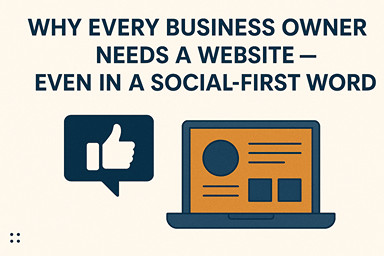Did you know that 80% of Kerala customers search online before buying, yet thousands of businesses still have no website?
In a digital-first economy, many business owners rely only on Facebook, WhatsApp, or Instagram. But here’s the truth — social-first doesn’t mean social-only. If you don’t have a website, you’re invisible where it matters most.
From Google rankings to customer trust, a website is your most valuable digital asset. Even small Indian businesses are seeing big returns from simple, SEO-ready websites.
This post shows you why you need a website in 2025, what you lose without one, and how to build a site that actually grows your business.
What’s in This Post
Understanding Why Businesses Need a Website
A business website is your digital home. It’s the one place you fully own and control, unlike social media platforms that can change rules or disappear.
In 2025, a well-built website helps customers find you, trust you, and buy from you. It ranks on Google, showcases your work, and collects leads 24/7.
✨ Important Point: A website is not a cost. It’s an investment in long-term visibility and credibility.
Current Practices and Why They Fail
Many Indian businesses rely only on Instagram, Facebook, or WhatsApp. These platforms are great for discovery but poor for search, credibility, or structured communication.
Most social pages don’t show up on Google, and algorithms change often, limiting your reach. Worse, messages and DMs get missed or buried.
✨ Important Point: Social posts vanish in 24 hours. SEO content stays for years.
Common Mistakes in Online Presence
No website or outdated website
Relying only on DMs for leads
No SEO-friendly content
Missing contact details or portfolio
No lead forms or analytics tracking
A Better Approach to Online Presence
The better way? Use a professionally built website as your central hub.
It hosts all your information in one place: services, pricing, contact, portfolio, blog, and lead forms. It supports SEO and integrates with your social media, not competes with it.
✨ Important Point: A website makes all your marketing work harder and smarter.
Main Ideas of the New Method
SEO-optimised content to rank on Google
Fast-loading, mobile-first design
Contact forms and WhatsApp integration
Lead magnets and newsletter signups
Analytics to measure visitor behaviour
Benefits of Having a Website
A great website attracts, engages, and converts visitors into customers.
You show up in Google for real keywords. You look credible. And you make it easy for people to reach you, get info, and take action.
✨ Important Point: Your website works 24/7, bringing leads while you sleep.
Things That Get Better
More leads from Google search
Faster trust-building with visitors
Higher engagement with blogs and offers
Better conversion from ads to inquiries
Clearer communication of brand and services
How to Build a Conversion-Ready Website
First Step: Define Your Goal
Do you want leads, bookings, sales, or support requests? Build the website around one goal.
Second Step: Write SEO Content
Use keywords your customers search like “best interior designer in Kochi” or “steel fabrication in Riyadh”. Add a blog to support this.
Third Step: Use Smart Features
Include mobile design, CTA buttons, live chat, and social proof (testimonials). Add Google Analytics and forms.
👉 Expert Advice: Always keep your website updated, fast, and secure.
Real Case: Website Success Story
The Problem: Missing Local Leads
A tile business in Malappuram relied only on Instagram. They missed Google searchers looking for “affordable tiles near me”.
What They Did: Built an SEO Website
They added photos, testimonials, WhatsApp chat, and wrote local keyword-rich pages.
What Happened: 3X Growth
Their Google traffic grew 300% in 6 months. Inquiries increased. Customers trusted them more.
Best Practices to Follow
Top Method 1: Keep It Mobile-First
More than 85% of traffic is from phones. Your site must load fast and look clean.
Top Method 2: Write Local SEO Pages
Target your city or niche. Add keywords like “event planner in Coimbatore” or “custom shirts in Bandra”.
Top Method 3: Use Lead Forms and WhatsApp
Make it easy to contact you. Don’t rely on DMs.
🔝 Important Point: Combine design, content, and speed for best impact.
Best Practices to Follow
Top Method 1: Keep It Mobile-First
More than 85% of traffic is from phones. Your site must load fast and look clean.
Top Method 2: Write Local SEO Pages
Target your city or niche. Add keywords like “event planner in Coimbatore” or “custom shirts in Bandra”.
Top Method 3: Use Lead Forms and WhatsApp
Make it easy to contact you. Don’t rely on DMs.
🔝 Important Point: Combine design, content, and speed for best impact.
Common Website Mistakes & Fixes
Problem 1: Slow Loading Speed
Fix: Compress images, use CDN, avoid heavy plugins.
Problem 2: No SEO Content
Fix: Add keyword pages, blog posts, and update monthly.
Problem 3: Not Mobile-Friendly
Fix: Use responsive themes and test on phones.
👉 Expert Advice: Use tools like Google PageSpeed and Ubersuggest to audit your site.
What’s Coming Next in Digital Business
New Trend 1: Voice Search Optimization
People ask Google things like “where can I buy jute bags near me?”
New Trend 2: AI Website Assistants
Live chatbots that answer FAQs and collect leads instantly.
New Trend 3: Hyperlocal Content
Google now shows more results based on exact location.
✨ Important Point: Your site must grow with trends — not get left behind.
FAQs
Q: Why can’t I just use Instagram?
A: Instagram helps with discovery, but people go to Google when they’re ready to buy. Your website shows up there, not your Instagram profile.
Q: What if I run a small business?
A: Even a simple one-page site can help you get found, look credible, and capture leads.
Q: How much does a website cost?
A: It varies. A starter site in India can cost ₹5,000 to ₹20,000. But it pays off long-term.
What to Do Next
A business website is not optional in 2025 — it’s essential.
It builds trust, drives search traffic, captures leads, and supports your social media. Don’t wait till you lose customers to realise this.
Action Steps:
Book a free website consultation with our team.
Check if your business name shows up on Google.
Start writing keyword ideas customers might search.
We’d love to hear your thoughts! Do you already have a business website? How has it helped? Share your experience below or drop a question.




